Here's where you'll find out what character-specific tropes are embodied among the eighty-plus character classes and the story and worldbuilding provided by all the non-player characters in Tree of Savior.
- Swordsman

- "The capital may already be in ruins, but I will protect Klaipeda."
The starter class for specialists in melee combat, the skillset of a Swordsman encourages trading defense for attack strength.
Tropes associated with Swordsmen:
- Blade Spam: Double Slash is a two-strike version of this. It'll do even more damage if used on a bleeding foe.
- Cast from Hit Points: Restrain temporarily reduces a Swordsman's maximum HP in order to increase the chance of stunning an enemy dramatically.
- Knockback: Swordsmen have one skill that's designed to cause this, Thrust.
- Immune to Flinching: Pain Barrier temporarily renders a Swordsman immune to knockback, knockdown, and stun attacks.
- Herd-Hitting Attack: Bash works this way, hitting all enemies in a forward arc.
- Pistol-Whipping: Or the sword variant of it anyway, which is called Pommel Beat here. This attack does added damage to stunned foes, and partially ignores the defense of Medium or Small-sized enemies.
- Stance System: When using Gung Ho, Swordsmen become more like Glass Cannons, trading physical defense for physical attack strength.
- Highlander

- "Using all your power to crush any enemy that would threaten the Kingdom. That's how Highlanders fight in battle."
One of the classes available to Swordsmen when they reach Rank 2. Highlanders are loosely based on the light infantry of medieval Scotland's highlander clans, and emphasize two-handed sword combat and whacking their enemies around as if they were golf balls.
Tropes associated with Highlanders:
- Armor-Piercing Attack: Highlanders can break the enemy's defense with a Skull Swing.
- Blade Spam: Moulinet delivers a five-hit frenzy to enemies in front of the Highlander.
- Man in a Kilt: And a woman in a kilt, too!
- Punched Across the Room: Highlanders have two sword-based versions of this—
- After a whirl of the sword, Wagon Wheel causes this in addition to splash damage.
- Cartar Stroke works similarly, but Highlanders can learn an attribute that will deal additional damage to an enemy that hits a wall after getting hit.
- Stance System: Crossguard increases the defense and probability of blocking enemy strikes. An enemy thus blocked is vulnerable to a riposte from a stab attack.
- Stupidity-Inducing Attack: Crown is an overhead strike that reduces an enemy's Intelligence and Spirit temporarily.
- Peltasta

- "It is a vain death that lies at the end for those who seek only dauntlessness. If you wish to achieve true justice, lift a Peltasta's shield."
The other class available at Rank 2. Loosely based on the peltast skirmishers of Classical Greece, these warriors emphasize shield-based combat skills. As a result they are more defensive fighters when compared to Highlanders.
Tropes associated with Peltasti:
- Defend Command: One of the attributes that a Peltasta can learn allows them to assume a defensive stance with a keypress.
- Luckily, My Shield Will Protect Me: Their skills and attributes both emphasize the use of a shield.
- Pink Girl, Blue Boy: Inverted—both genders have identical uniforms, but female Peltasti wear blue trim, while male Peltasti wear red.
- Practical Taunt: Swash Buckling is a form of this—Peltasti beat their shield threateningly to provoke enemies into attacking them. (Shouting Chivalry: Medieval Warfare taunts while doing so is completely optional.)
- Shield Bash: Two skills involve beating enemies with the shield—
- Umbo Blow involves the Peltasta spinning like a top before bashing with the shield.
- Rim Blow involves striking with the edge of the shield.
- Stance System: Comes in two flavors—
- With the Guardian skill, a Peltasta trades damage output for physical defense.
- Using High Guard, a Peltasta can increase the chance of blocking attacks in exchange for losing some attack strength and chance for landing critical hits.
- Throwing Your Shield Always Works: Peltasta can do this with Shield Lob, although they will receive a defense penalty until their shield returns to them
- Hoplite

- "The spear in itself is a weapon of pure destruction. It is the best weapon anyone can easily learn and master."
One of the classes available to Swordsmen at Rank 3. Like the Peltasti, Hoplites are loosely based on the hoplite citzen-soldiers of Classical Greece. Their skillset is based around the use of spears in combat.
Tropes associated with Hoplites:
- Battle Ballgown: Both female and male Hoplites wear something like an armored dress.
- Javelin Thrower: A third circle Hoplite can do this with Spear Throw.
- In a Single Bound: Long Stride allows a Hoplite to leap to a desired location, doing damage to nearby targets when they land.
- Situational Damage Attack: The number of times that Pierce hits an enemy will depend on its size. The larger the foe, the more damage done.
- Spam Attack: Done with the Stabbing skill—once activated, rapidly tapping the hotkey to which the skill is bound will cause the Hoplite to shower foes with rapid-fire thrusts.
- Stance System: By using Finestra, Hoplites change their grip to an overhand thrust. This increases their chance for landing critical hits, but reduces their evasion.
- Barbarian
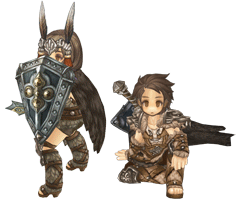
The other class available to Swordsmen once they reach Rank 3. Reckless and aggressive, Barbarians specialize in two-handed swords just as Highlanders do, but their skillset is more about increasing damage output with buffs rather than knocking enemies around.
Tropes associated with Barbarians:
- Always Accurate Attack: Aggressor will turn a Barbarian's blows into this, but at the cost of a decreased chance at landing (and dodging) Critical Hits.
- Damage Typing: Barbarians get a skill that affects this—Savagery. It causes their attacks to hit twice, first as a Stab-property attack and then as a Strike-property.
- Foe-Tossing Charge: Using the Pouncing skill, a Barbarian will charge forward in a straight line, tearing through enemies in the way.
- Goomba Stomp: Barbarians can do this with the Stomping Kick skill—in fact, its damage is determined by the defense rating of the shoes they're wearing, as well as how high they were before falling on top of their target.
- Human Hammer-Throw: Giant Swing lets Barbarians do this by tying enemies to the end of a rope. So long, a-monster!
- Impaled with Extreme Prejudice: Embowel involves Barbarians impaling a foe with their sword, then kicking the hapless enemy clear off.
- Screaming Warrior: Warcry decreases the defense of nearby enemies. The sum amount of defense reduced this way is then added to the Barbarian's attack strength.
- Roldelero

Available to Swordsmen at Rank 4, Rodoleros are based on Renaissance-era Spanish (and Italian) soldiers of the same name. Like Hoplites, they emphasize shield usage, but their skillset emphasizes using the shield as a weapon in its own right.
Tropes associated with Roldeleros:
- Agony of the Feet / Knee-capping: Montano allows a Rodolero to aim for the legs (or lower body) of a target to immobilize them.
- Foe-Tossing Charge: Compared to the ones Barbarians have, the Rodoleros' Shield Charge skill knocks enemies out of the way rather than mow them down.
- Shield Bash: Rodoleros get two flavors—
- Shield Push can interrupt an enemy's actions and leave them off balance.
- With Targe Smash, Rodoleros grab their shield by its edges and bring it down hard on the head of their enemy. Enough that it might actually leave them blind!
- Cataphract

The other class available to Swordsmen once they reach Rank 4. Cataphracts are based on the eponymous heavy cavalry used by peoples of the Middle East and Central Asia. They're capable of riding their companion into battle and attacking while on the move.
Tropes associated with Cataphracts:
- Dash Attack: The Steed Charge works this way, as it requires steed and rider to "charge up" before rushing forward in a burst of speed.
- Spin Attack: Rush is a variation in which Cataphracts spin their spear over their heads for a period of time. Since Cataphracts can do this while their mount is on the move, this winds up closer to a Foe-Tossing Charge.
- Impaled with Extreme Prejudice: Done with the aptly named skill Impaler.
- Turns into Grievous Harm with a Body because the target remains impaled on the spear, and subsequent uses of Impaler will whack them into other targets.
- Shockwave Stomp: Earth Wave involves Cataphracts gathering strength before slamming their spear into the ground, causing one of these.
- Sprint Shoes: Trot allows a Cataphract's mount to move faster for a period of time.
- Squire
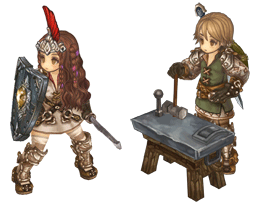
One of the classes available to Swordsmen upon reaching Rank 5, named after medieval apprentices to knights. Their skillset is heavily inspired by the duties of their historical counterparts, namely in their ability to maintain and supply other adventurers.
Tropes associated with Squires:
- Caught in a Snare: Using Arrest, Squires can temporarily bind targets and keep them from moving. This includes bosses.
- Healing Checkpoint: Squires can set up something like this for their party with Base Camp, which provides a location to teleport to and fro, on-site item storage, and an increase to the duration of skill and food-based buffs.
- Food Table is a skill that works in tandem with this one, which allows party members to cook food that gives stat boosts. It can only be deployed near a base camp, though. Disband the base camp, and the table goes with it.
- Reforged Blade: And armor, too, with the Repair skill. Squires can also temporarily improve weapons and armor with the Repair Weapon and Repair Armor skills. In all three cases, the Squire opens an automated stall, allowing anyone to make use of their services for a fee.
- The Squire
- Corsair
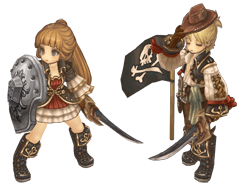
The other class available to Swordsman at Rank 5. They are the closest thing Tree of Savior has to Ragnarok Online's Thieves. They specialize in using two blades at once as well as pilfering—both from enemies and from treasure chests.
Tropes associated with Corsairs:
- Blade Spam: Double Weapon Assault temporarily cuts down on the delay between using their primary and off-hand weapons, resulting in a flurry of strikes.
- Dual Wielding: A sword in one hand, a dagger in the other
- Sword and Gun: By Circle 3, Corsairs can opt to equip a Pistol as a subweapon instead of a dagger.
- Dressed to Plunder
- Pirate
- Pirate Booty: With Unlock Chest, a Corsair can unlock a treasure chest with a lower leveled key (depending on how much they leveled Unlock Chest).
- Video Game Stealing: While the Steal skill is active, a Corsair has a chance of taking an item from an enemy with every attack—so long as Jolly Roger is also active.
- What a Drag: After a Corsair has captured an enemy with the Iron Hook skill, they can then use Keelhauling to drag the hapless foe over to them, dealing damage the entire time.
- Fencer

One of the classes that Swordsmen can pick from at Rank 6. Fencers are skilled in the art of fencing can equip rapiers. Through deft footwork and nimble movements, they can rapidly hit successive strikes.
Tropes associated with Fencers:
- Death by a Thousand Cuts: Sept Etoiles performs a serious of rapid stabs.
- Dodge the Bullet: Lunge, Esquive Toucher, Flanconnade, and Preparation all boost your evasion rate during the attack. Fencers in general have among the highest evade of all classes.
- Logical Weakness: Because evade only effects physical attacks in Tree of Savior, Fencers are particularly vulnerable to magic, especially if they do not gear up against it.
- Pistol-Whipping: Attaque Coquille, is an Armor-Piercing Attack that strikes with the hilt of the rapier
- Royal Rapier: Exclusive to Fencers.
- Doppelsöldner

The other class available to Swordsmen at Rank 6. The Doppelsöldner (both singular and plural) are based on a certain kind of landsknecht from Renaissance-era Germany. The name literally means "double-paid mercenary," which is prcisely what they were—landsknechte who volunteered to fight in the vanguard for double the pay. Tree of Savior's Doppelsöldner specialize in Zweihanders, a sword their historical counterparts are famed for using to break formations of pikemen.
Tropes associated with Doppelsöldner:
- Blade Spam: With Deeds of Valor, their attack speed quickens while their defense decreases.
- Coup de Grâce: Once an enemy has been knocked down, a Doppelsöldner can use Punish to make sure they never get back up again.
- Experience Booster / Money Multiplier: When Doppelsöldner activate Earn Double Pay, the EXP and drop rate of enemies doubles. What's the catch, you might ask? They only get that reward if they kill their target within a set amount of attacks. Oh, and the damage they receive is tripled—if they die, they take a heavier penalty to equipment durability than normal.
- Pistol-Whipping: Similar to a Swordsman's Pommel Beat, Mordschlag involves a Doppelsöldner holding their sword in both hands by the blade and whacking their foes with the hilt. Hard. It does more overall damage than Pommel Beat, though it doesn't do added damage to stunned foes, nor will it ignore the damage of Medium and Small-sized enemies.
- Spin Attack: Cyclone causes Doppelsöldner to turn into whirlwinds of death for a period of time.
- Dragoon

One of the classes available to Swordsmen at Rank 7. Their namesake derive from mounted cavalry throughout Europe's military history. These Dragoon's however greatly resemble their Final Fantasy counterparts, specialized in using two-handed spears and sweeping attacks
Tropes associated with Dragoons:
- Dragon Knight: Namesake aside, they possess and number of attacks that are dragon themed in name, such as Dragon Soar, Dragontooth, and Serpentine
- Javelin Thrower: Gae Bulg allows Dragoons to throw their spears, but they will suffer a damage penalty until they are picked up again
- Shoryuken: Dragon Soar cause Dragoons to vault upwards, carrying enemies along their spear
- Templar

Another class available to Swordsmen at Rank 7. Based off the Templar from the Order of Solomon's Temple, Templar are the only class in the game that can create guilds as well as become guild leaders.
Tropes associated with Templars:
- Warp Whistle: Summon Guild Member allows you to summon a guild member to your location, while Warp to Guild Member allows you warp to a guild member's location
- Shinobi
A hidden class, available to Swordsmen at Rank 7. Based off assassins from feudal Japan, Shinobi utilize gunpowder and shadow clones in their attacks.
Tropes associated with Shinobi:
- Action Bomb: Mijin no Jutsu turns the Shinobi into this, blowing everything around them up, but doing massive damage to them in the process
- Doppleganger Attack: Bushin no Jutsu creates clones of the player mimics their attacks.
- Invisibility: Skill attributes for Katon no Jutsu and Mijin no Jutsu allow the Shinobi to become stealthed after their attacks
- Ninja Log: Mokuton no Jutsu allows the Shinobi to escape and swap places with a log.
- Stock Ninja Weaponry: Can throw kunai as a skill
- Stuff Blowing Up: Katon no Jutsu and Mijin no Jutsu create powerful explosions at the cost of gunpowder.
- Lancer
One of the classes available to Swordsmen at Rank 8. Lancers are a spear wielding cavalry class that excel in pvp, being able to knock down others from their mounts, resist and destroy enemy magic circles, and silence enemies.
Tropes associated with Lancers:
- Mage Killer: Joust charges at and silences enemies struck while destroying magic circles in the area
- Murmillo
One of the classes available to Swordsmen at Rank 8. Based off a kind of gladiator in Ancient Rome. The Murmillo is a shield wielding class with a strong offensive edge. They gain the ability to equip a helmet known as the Cassis Crista, which lowers their movement speed and evade, but increases their block chance. They also use their shields more aggressively than Peltastas or Rodoleros, often using them to smack enemies aside mid combat
Tropes associated with Murmillos:
- Cool Helmet: The Cassis Crista
- Shield Bash: One of their skills has them repeatedly whack aside nearby enemies with their shield.
- Matador
Tropes associated with Matardors:
- Badass Cape
- Counter-Attack: Muleta acts as a counter move.
- Royal Rapier: Similar to Fencers, they wield Rapiers.
- Toros y Flamenco: Their major theme, being based off of Spanish Bullfighters.
- Retiarius
Tropes associated with Retiarii:
- Wizard

- "No matter how much magic talent you have, it is useless unless you train hard."
As one might surmise, Wizards and their related classes are the chief employers of combat magic in Tree of Savior.
Tropes associated with Wizards:
- Beehive Barrier: The Reflect Shield looks and works like one, returning a certain number of blows to sender.
- Dishing Out Dirt: Wizards have only one earth-affecting skill, Earthquake.
- Forced Sleep: Performed via Sleep, which enemies will wake from after being hit a number of times, or after a set period.
- A variant of this can be found in Lethargy, which makes enemies drowsy and hampers both their evasion and damage output.
- Immune to Flinching: Surespell prevents the next spell a Wizard casts from being interrupted.
- Projectile Spell: A Wizard's normal attack (with wands at least) involves throwing small magical blasts. Their basic skill, Energy Bolt, is a heavy-duty variant that causes splash damage.
- Magic Missile Storm: The Magic Missile spell works like this—a Wizard instantly sends out three bolts of energy which spread out and converge on the target.
- Pyromancer

- "Fire is grace sent to us by the Goddess Grabija. You cannot become a great Pyromancer if you overlook that."
One of the two classes available to Wizards at Rank 2. As their name suggests, Pyromancers deal in all things hot and fiery.
Tropes associated with Pyromancers:
- Breath Weapon: A Pyromancer that learns the Hell Breath skill can breathe fire like a flamethrower.
- Finger-Snap Lighter: Pyromancers do this to cast Flare.
- Kill It with Fire: Every skill in a Pyromancer's toolkit causes Fire elemental damage in some way.
- Playing with Fire
- Red Oni, Blue Oni: Pyromancers are expected to be passionate and spiritual about their craft, which makes them Red Onis to a Cryomancer's Blue.
- Religious Bruiser: Both the Pyromancer Master and books found in her lab stress the importance of the Goddesses in their work. In fact, one book holds that Clerics and Wizards both work their powers through divine grace—they just apply it differently.
- Spell Blade: Enchant Fire allows a Pyromancer to add a fire element to basic attacks. Flaming Swords for everybody!
- Why Am I Ticking?: Flare allows a Pyromancer to cause any target that's affected by a status ailment (with the exception of frozen or petrified targets) to explode.
- Cryomancer
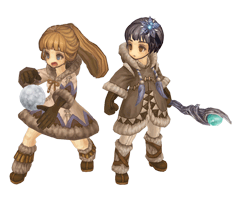
- "Intelligence, calm judgement and cold rationality. These are the qualities required for our Cryomancers."
The other class available to Wizards at Rank 2. Aside from the obvious—specializing in ice and cold—Cryomancers differ from Pyromancers in that their skillset is more oriented toward crowd control and area of effect spells.
Tropes associated with Cryomancers:
- An Ice Person: With the exception of two skills, every spell a Cryomancer knows has a chance of freezing enemies.
- Barrier Warrior: The Subzero Shield spell causes enemies who attack the Cryomancer to freeze while the spell is in effect.
- In general, a Cryomancers' ice spells shape the battlefield, creating barriers that enemies can't pass.
- Blow You Away: Gust conjures a blast of wind to push foes around. Despite being a wind-based spell, it still causes Ice-elmental damage—perhaps, due to wind chill.
- Elemental Barrier: Subzero Shield creates shields of ice that will block (and potentially freeze) enemies who attempt to attack the Cryomancer.
- Kill It with Ice: Exclusively so.
- Grievous Harm with a Body: If there's any frozen enemies on the field, a Cryomancer can use Gust to smack them into other foes.
- Red Oni, Blue Oni: As the Cryomancer Master says that their field of study requires an intellectual and rational approach, that makes them Blue Onis to the Pyromancers' Red.
- Snowball Fight: A third circle Cryomancer can learn Snow Rolling—which involves conjuring a giant snowball, then riding on top of it to crush enemies beneath.
- Psychokino
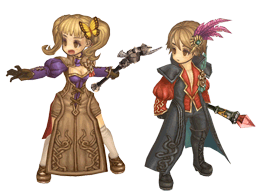
- "Belief in yourself. Endless confidence. These are the most important things when projecting yourself in reality. That is the nature of Psychokino and the power that moves the world."
One of the classes available to Wizards starting at Rank 3. Psychokinos specialize in the power of the mind, namely in using the mind to move just about anything not nailed down.
Tropes associated with Psychokinos:
- Grievous Harm with a Body: Using Telekinesis, Psychokinos can slam an enemy around, dealing damage to other nearby enemies in the process.
- Mind Rape: Psychic Pressure continually damages a target while leaving them unable to fight back.
- Random Teleportation: Teleporation moves the Psychokino to a nearby location at random.
- Switch-Out Move: Swap lets Psychokinos trade physical locations with their target instantly.
- You Will Not Evade Me: Comes in two flavors—
- Magnetic Force is an area-of-effect spell that draws in nearby targets and continually damages them.
- Gravity Pole anchors a hapless target in a straight-line field of gravity.
- Linker
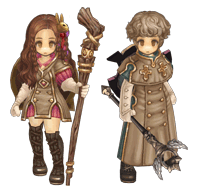
- "A Linker is someone who connects people with ropes of Mana. How strong the connection is depends on the quality of Mana."
The other class available to Wizards at Rank 3. This class is support-minded, and specializes in linking both friends and foes alike to share strength or weakness.
Tropes associated with Linkers:
- Synchronization: Comes in several flavors—
- Physical Link allows Linkers to evenly distribute damage done between themselves and whoever's linked to them.
- Joint Penalty works similarly for foes, except that all linked enemies receive full damage from an attack.
- Spiritual Link allows a Linker to share buffs with other party members, while Life Line further boosts that skill.
- Thaumaturge

One of the classes available to Wizards at Rank 4. Thaumaturges specialize in changing the attributes of things—turning enchantments against their casters, modifying physical attributes, or (especially) causing bodies and body parts to shrink or grow in size.
Tropes associated with Thaumaturges:
- Beat Them at Their Own Game: Reversi allows a Thaumaturge to take ownership of magic circles and ground enchanted by the enemy, as if the Thaumaturge was the one who cast them.
- Big Head Mode: Swell Brain will temporarily enlarge the heads of everyone in a Thuamaturge's party while increasing their Intelligence. From the name, you'd think it'd cause meningitis instead.
- Make My Monster Grow: Thamaturges do this to their enemies with Swell Body, and the inverse with Shrink Body.
- Painful Transformation: Thaumaturges can learn the Swell Pain and Shrink Pain attributes to damage their targets as they expand or contract.
- Sizeshifter: Swell Left Arm and Swell Right Arm temporarily expand those respective body parts, which also makes whatever weapons or shields they're holding more effective.
- Elementalist
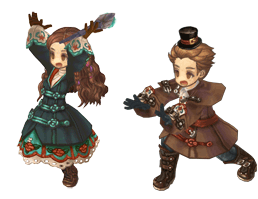
The other class available to Wizards at Rank 4. The Elementalist's toolkit is chiefly comprised of spells which do high damage and (often) hit multiple targets within an area, but have a long cast time, making them the Nukers of Tree of Savior.
Tropes associated with Elementalists:
- Chain Lightning: This is how Electrocute manifests.
- Death from Above: In three flavors (Fire, Ice, Lightning) no less!
- The Power of the Sun: Elementalists can create small, man-sized solar prominences with the Prominence skill. The prominences created this way will persist for a short time, wandering around the field like giant burning slinkies of doom.
- Taken for Granite: Elementalists get to do this with Stone Curse.
- Weather Manipulation: The Rain spell causes a rainstorm (even indoors and underground!) which has a number of effects, from reducing enemy movement speed to randomly pelting them with lightning.
- Sorceror

One of the classes available to Wizards upon reaching Rank 5. Sorcerors summon demonic creatures to do their bidding, including massive devils who take the shape of boss monsters, provided the Sorceror has the right cards.
Tropes associated with Sorcerors:
- Action Bomb: Summon Familiar gives Summoners a demonic bat that will, upon the Summoner attacking (or getting attacked by) an enemy, will explode itself on the nearest foe.
- Beast of Battle: Using Ride, a Summoner will clamber on top of their summoned devil. From there, the Summoner has direct control over the devil's actions, and is even able to use its skills!
- The Beastmaster: Even on foot, Summoners can give commands to the summoned devils through Attack Ground and Hold. They can also summon three other creatures, such as a fire devil called a Salamion that automatically follows and attacks foes.
- Cats Are Magic: At least, the ones summoned by Summon Servant are. Servants provide boosts to SP recovery, attack range, stamina recovery, magic defense, and the strength of Dark elemental attacks.
- Involuntary Shapeshifting: Not on themselves, but on the devils they summon. The Variation skill will make the devil shift to an alternate form, provided a second card is loaded into the Grimoire.
- Living Shadow: The devils summoned via Summoning appear pure black and smoky. The form they take, however, depends on the boss card that Summoners have currently loaded into their Grimoire.
- Stripperiffic: For both female and male Sorcerors—and strangely, in both cases, includes a dress.
- Walking Shirtless Scene: Male Sorcerors are largely topless, with two straps crossing their chest.
- Chronomancer

The other class available to Wizards at Rank 5. Chronomancers, as their name implies, specialize in changing the flow of time—speeding it up, reversing it, stopping it entirely.
Tropes associated with Chronomancers:
- Insubstantial Ingredients: In order to use Back Masking, a Chronomancer requires one Piece of Dimension per use.
- Reset Button: Two flavors at a Chronomancer's disposal—
- If a Chronomancer casts Reincarnate on an enemy, they will reappear right after being killed, good as new.
- Back Masking allows a Chronomancer restore a previous temporal state of things in a given area.
- Time Master
- Time Stands Still: Inverted with Stop, in which a Chronomancer temporarily halts time for enemies caught in the spell's area of effect. Interestingly, Stop also prevents damage to enemies halted this way.
- Year Outside, Hour Inside: Slow works on this principle, controlling the flow of time around a target so that they move slower than normal.
- Year Inside, Hour Outside: Both Haste and Quicken work on this principle—controlling time flow for the Chronomancer (or an ally) to speed up movement (for Haste) or attack speed (for Quicken).
- Necromancer

One of the classes available to a Wizard once they reach Rank 6. Necromancers are ... not exactly like your typical zombie-raising spellcaster. Rather than controlling the undead, they use the Ludicrous Gibs of slain foes as a resource for spells.
Tropes associated with Necromancers:
- The Beastmaster: Similar, but not quite identical, to Summoners. Instead of a Grimoire, Necromancers have a Necromonicon, into which they they can insert Animal, Plant, and Mutant type cards. These determine the form of the Shoggoth created.
- Improvised Golem: Using the gibs they've collected, Necromancers can use Create Shoggoth to make one of these. The shoggoth thus created will look like a mashup of gibs from the dead enemies the Necromancer used to create it, in the rough outline of the boss monster card equipped in the Necromonicon.
- Lovecraftian Superpower: Let's reiterate—they use a Necromonicon to create Shoggoths. Beyond that, the bulk of their powers involves collecting the shattered pieces of their foes to either use as projectiles (with Flesh Cannon), as a damaging personal shield (with Flesh Hoop) or as a barrier that rots enemies on contact (with Flesh Wall).
- Orbiting Particle Shield: Flesh Hoop works this way.
- Alchemist

Another class available to Wizards at Rank 6. The bulk of an Alchemist's skillset has to do with item crafting and modification.
Tropes associated with Alchemists:
- Beachcombing: Alchemists can use Dig to find crafting materials. Not quite an example of Metal Detector Puzzle, as this is a general skill Alchemists have and it's not part of a quest.
- Equipment Upgrade: This and more generally applied to items. Alchemists have several skills in this category—
- Gem Roasting is a service that Alchemists can perform for others (for a monetary fee, of course), in which the Alchemist reduces the negative penalties a gemstone confers to equipment once socketed.
- Briquetting combines two items together to modify the combined item's properties. The combined item will have decreased Potential, and it's not a certainty that the item's statistics will be improved.
- Item Awakening is the most unique one of the bunch—taking a nod from the Disgaea series, an Alchemist enters the world of the item in question. Clearing the item's dungeon will make its hidden ability available for use, but doing so does reduce the item's Potential gauge by a bit.
- Potion-Brewing Mechanic: Alchemists handle this through Tinticuring. Gaining the ability to craft more than one kind of potion is based on gathering recipes rather than learning skills (as was the case in RO).
- Rune Caster
A hidden class available to Wizards at Rank 6. Rune Casters utilize runes as attacks or boons.
Tropes associated with Rune Casters:
- An Ice Person: Rune of Ice increases the ice damage of the entire party
- Instant Runes: Averted, all of the Rune Caster's skills take around 8 seconds to cast. Though Quick Cast can cut the duration down.
- Make My Monster Grow: Rune of Giants allows the Rune Caster to turn themsleves or their allies into giants, increasing their health.
- Warlock

One of the classes available to Wizards at Rank 7. Warlocks summon and control evil spirits to do their bidding. They can send spirits flying towards enemies, or have them orbit around themself for protection.
Tropes associated with Warlocks:
- Action Bomb: Can command their summoned spirits to home in on and explode a designated location.
- Casting a Shadow: Almost all Warlock skills are of the dark element
- Featherfoot

The other class available to Wizards at Rank 7. Loosely based off the Kurdaitcha of Aboriginal Australian culture, the Featherfoot specializes in draining health from enemies and cursing them.
Tropes associated with Featherfeet:
- Cast from Hit Points: In Circle 2 they can consume around 60% of their max health to create a bloody explosion, dealing massive damage.
- Flight: Through Levitation they gain the ability to hover above magic circles and melee attacks.
- Healing Factor: Downplayed, one of their passive attributes increases the amount of Hp and Sp they heal from skills and potions
- The Power of Blood: Blood Bath and Blood Sucking allow the Featherfoot to drain the health of devil, insect, or beast monsters.
- Sage
One of the classes available to Wizards at Rank 8. Sages study the workings of reality, able to directly manipulate space and dimensions. They can set up portals to quickly go between towns and maps, and can duplicate objects on the battlefield created from skills.
Tropes associated with Sages:
- Cool Gate: Can summon portals for both combat or travel.
- Reality Warper: Their main shtick, being able to manipulate space to their advantage.
- Enchanter
One of the classes available to Wizards at Rank 8. Enchanters are a merchant class, able to craft their magic skills into scrolls and sell them to other players. They can also directly sell enchanments onto equipment, boosting their stats for a duration.
Tropes associated with Enchanters:
- Vancian Magic: What their scrolls function as. Essentially a single spell use
- Shadowmancer
Tropes associated with Shadowmancers:
- Casting a Shadow
- Shadow Pin
- Shadow Walker: Shadow Pool allows them to sink into the shadows
- Onmyoji
Tropes associated with Onmyoji:
- Archer
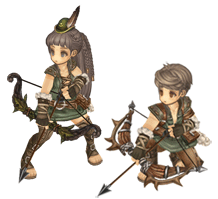
- "Killing enemies one by one from a distance is the beauty of the bow and arrow. No matter how many shots you make, it's the actual shots that count, isn't it?"
Archers are the starting class for those who prefer to pelt their enemies from afar with a rain of arrows. Archers in Tree of Savior can draw and loose their bows while moving.
Tropes associated with Archers:
- Bottomless Magazines: Be it a bow, a gun, or a cannon. Archers never seem to run out of arrows. Save for a few special ammunitions.
- Chained Heat: Full Draw will fully penetrate an enemy and skewer them to another nearby enemy, leaving them temporarily stuck together.
- Long-Range Fighter: An Archer's primary defense is distance from their target.
- Pinball Projectile: Using Oblique Shot will cause the arrow to glance off of the target and damage a single nearby enemy as well.
- Multishot: Twin Arrow lets an Archer fire two arrows at once.
- Rain of Arrows: Although Archers have a skill called Multi Shot, it involves rapidly shooting a number of arrows after a charge period.
- Stance System: Using Kneeling Shot will cause an Archer to assume a kneeling position that increases range and damage, but sacrifices mobility.
- Ranger

- "I heard the monsters are moving in herds outside Klaipeda. Instead of defeating them one by one, it will be better to learn my skills."
One of the classes available to Archers starting from Rank 2. Rangers specialize in attacking multiple targets at once, expanding on the Archer's skills.
Tropes associated with Rangers:
- Multishot: Barrage lays down five arrows in a forward arc.
- One-Hit Polykill: High Anchoring causes Rangers to draw their bowstrings tighter than normal in order to send an arrow clear through a line of targets in front of them.
- Pinball Projectile: If a Ranger kills a target with Bounce Shot, multiple arrows will bounce off to other targets.
- Another skill, Spiral Arrow, causes an arrow to repeatedly strike the same target, bouncing off of things to come right back at the hapless foe again and again.
- Stance System: If a Ranger uses Steady Aim, they'll trade attack speed for attack power. They can mitigate the attack speed lost by learning the right attribute.
- Trick Arrow: Using Time Bomb Arrow will result in shooting explosive arrows that detonate after a period of time.
- Quarrel Shooter
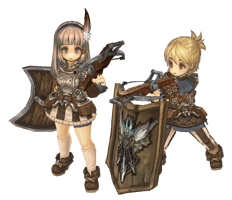
- "You are easily exposed to enemy attacks when you are using a bow. So my strategy is to use anything such a as a shield or a stone to protect myself."
The other class available to Archers upon reaching Rank 2. Quarrel Shooters differ greatly from Rangers in that they not only prefer crossbows to regular bows, but also employ the use of cover and anything they can find in the field to aid them.
Tropes associated with Quarrel Shooters:
- Brats with Slingshots: Using the Stone Picking skill, Quarrel Shooters can gather stones in the field—and using Stone Shot they'll fire them from their crossbows, which can stun and knock enemies back.
- Caltrops: Available through Scatter Caltrop, which reduces the movement of enemies that step on them while inflicting Damage Over Time.
- Deployable Cover: Deploy Pavise allows a Quarrel Shooter to set down a pavise shield, which will defend against enemy ranged attacks if they stand behind it.
- Using the Tear Down skill, Quarrel Shooters can then break their own pavise shield to damage foes in front of them.
- Do Not Run with a Gun: Subverted with the Running Shot skill, which allows you to run whilst auto attacking with your crossbow or mainhand weapon.
- Multishot: Rapid Fire is described as being the crossbow version of this trope (the Quarrel Shooter loads multiple arrows into the crossbow), although the shots are fired in rapid succession rather than all at once.
- Sapper

A class available to Archers once they reach Rank 3, Sappers are all about preparing traps for their enemies. They have a wide variety of traps at their disposal, even using their enemy's own enchantments against them!
Tropes associated with Sappers:
- Beat Them at Their Own Game: Detonate Traps can be used on magic circles or ground that's been enchanted by the enemy. It doesn't matter what the enchantment was supposed to do—it'll blow up in the enemy's face all the same.
- Booby Trap: The Conceal skill hides deployed traps from enemies for a time being.
- Grenade Tag: Collar Bomb is a variation—the bomb only goes off when the enemy thus tagged touches another enemy.
- Laser Cutter: The Broom Trap appears to manifest as one—it emits three rotating beams of light that damage anything in their path.
- Plunger Detonator: Sappers use these when detonating their Claymore mines.
- Spikes of Doom: Punji Stake consists of deploying a spring-loaded mechanism that, when stepped on by an enemy, flips a latticework of bamboo stakes into their face and knocks them away.
- Spike Shooter: Sappers get a skill named exactly this, albeit as a trap they can deploy. Any enemies led into the trap's killzone get shot full of spikes.
- Trap Master
- Hunter

The other class available to Archers at Rank 3. Hunters specialize in using working with their Companion to take down enemies.
Tropes associated with Hunters:
- All Animals Are Dogs: Hunters can use just about any Companion like they would an actual hunting dog.
- Angry Guard Dog: Growling will have the Companion assume the role of one. Enemies will keep their distance—those that don't have a chance of getting a Fear status ailment.
- Pointing works on a similar principle, except that the skill orders the Companion to reduce a target's evasion by running circles around them, fencing them in.
- Anti-Air: Snatching commands a Hunter's Companion to bite a flying target and pin them to the ground.
- The Beastmaster: A more traditional kind compared to the Wizard-derived pet classes, Hunters represent the "Loyal Animal Companion" flavor of the trope.
- The Nose Knows: Hounding orders a Companion to sniff out hiding enemies.
- Super-Persistent Predator: Order a Companion to Retrieve, and it will bite a target and drag it back toward you, no matter how big.
- Wugushi

One of the classes available to Archers at Rank 4, Wugushi appear to be based on shamans who specialize in poisons in China
Tropes associated with Wugushi:
- Blow Gun: Wugushi use one for their Needle Blow Damage Over Time skill.
- Magic Antidote: Subverted with Detoxify—while it can remove the Poisoned status ailment, if it's of a higher level than that of the Wugushi's Detoxify, then it will only reduce the amount of time that the afflicted is poisoned.
- Master Poisoner
- Poisoned Weapons: Wugushi make liberal use of these in their skills.
- Set a Mook to Kill a Mook: Using Bewitch on poisoned enemies will confuse them and turn them against their allies.
- Spawn Broodling: Jincan Gu involves shooting a target with silkworm poison—when the host is killed, venomous insects are born that attack other nearby foes.
- Technicolor Toxin: A Wugushi's poison skills typically have a neon green glow.
- Universal Poison: Poison is a damage type unto itself here.
- Scout
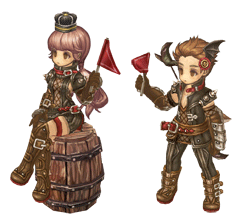
The other class available to Archers at Rank 4. Scouts specialize in stealth, misdirection, and reconnaisance.
Tropes associated with Scouts:
- Arrows on Fire: Flare Shot fires one of these. The fire and sparks it creates has an area of effect.
- Cooldown Manipulation: Be Prepared allows a Scout to instantly reduce the cooldown time remaining on all their skills.
- Defog of War: With Scan, Scouts can reveal all enemies hiding in front of them.
- Invisibility Cloak: The aptly named Cloaking skill works in this fashion, and is broken by jumping or attacking.
- Mobile Shrubbery: The Camouflage skill utilizes an apple barrel for this effect. They can attack while inside the barrel, and it will soak up a few hits in case the Scout is spotted.
- Target Spotter: Undistance allows a Scout's allies to attack outside their range.
- Throwing the Distraction: Using Flu Flu, Scouts fire a screeching arrow. Nearby non-player enemies will be attracted to the sound it makes when it hits its target. (If you're wondering, yes, there is such a thing
 as a flu-flu arrow.)
as a flu-flu arrow.)
- Rogue
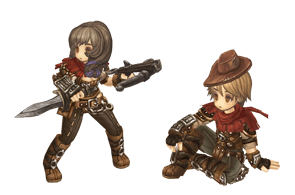
One of the classes available to Archers at Rank 5. Like Scouts, Rogues rely on deception and trickery, but they are more active in how they use it in combat.
Tropes associated with Rogues:
- Back Stab: Downplayed from the usual version of this trope, Sneak Hit temporarily boosts the probability of landing a Critical Hit when attacking from behind.
- Beat Them at Their Own Game: Like Thaumaturges and their skill Reversi, a Rogue can use Capture to take control of magic circles and ground enchanted by the enemy.
- Blade Spam: Backstep is a two-strike variant and has a high chance for landing Critical Hits as well as stunning the target.
- Deadly Gas: Lachrymator involves Rogues throwing a tear gas grenade, blinding enemies in the area of effect.
- Defeat Equals Explosion: Rogues invoke this on their enemies with the Vendetta skill. Enemies defeated this way also confer an attack strength buff to the Rogue's party.
- Defensive Feint Trap: Feint's description says that the skill reduces the enemy's evasion by tricking them into lowering their guard.
- Fast Tunnelling: Burrow instantly makes a Rogue sink underground. Burrowed Rogues can attack, but they can't move.
- Fletcher
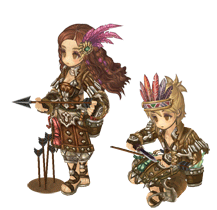
The other class available to Archers at Rank 5, Fletchers are also the crafting class of the Archer family. They still have a considerable combat skillset, though, geared toward using different arrow types.
Tropes associated with Fletchers:
- Anti-Armor: Fletchers have a strange version of this at their disposal in the form of the Barbed Arrow skill. This arrow will hit more than once depending on the type of armor their enemy has—cloth armor will get hit three times, leather armor twice, plate armor only once and ghost armor not at all.
- Armor-Piercing Attack: The Bodkin Point arrow not only temporarily decreases the defense of an enemy shot with it, it will also nullify any magical protection they have!
- Damage Over Time: A Fletcher using the Broadhead arrow skill can inflict the Bleed status ailment on their target.
- Trick Arrow: In addition to the more mundane arrow point skills, Fletchers have three at their disposal—
- Magic Arrow will set the ground below the target on fire, rapidly damaging them over time.
- Singijeon hits the enemy with an exploding arrow—unlike the Rangers' Time Bomb Arrow, Singijeon explodes shortly after contact.
- Cross Fire is the Singijeon's big brother. When that explodes, it creates a cross-shaped rippling explosion.
- Falconer

One of the classes available to Archers at Rank 6. Falconers are similar to Hunters in that they work with animals to defeat their enemies, but instead of using Companions, Falconers use birds of prey.
Tropes associated with Falconers:
- The Beastmaster: Like Hunters before them.
- Damage-Increasing Debuff: Using Circling, Falconers order their bird to fly around the target area, reducing the defense of enemies in its vicinity.
- Death from Above: When Falconers use Hovering, their bird will circle a target area and swoop down to attack enemies within it.
- Carrying Bird of Prey: A variation—with the Hanging Shot skill, Falconers can direct their raptor to pick them up for a period of time. While airborne, the Falconer can't be hit by attacks, but can freely shoot at enemies below (with the exception of using other skills).
- Motivation on a Stick: A variation—with the Pheasant skill, Falconers toss a stuffed animal pheasant at a target area. Their raptor will go after the doll, tearing through any nearby foes.
- Schwarzer Reiter

The other class available to Archers at Rank 6, based on the Schwarze Reiter ("Black Rider") pistol-wielding cavalry from (primarily) the German states of the 16th century. As with the Doppelsöldner, their name is both singular and plural. Like their namesake, Schwarzer Reiter fight with pistols and can ride their Companions into battle.
Tropes associated with Schwarzer Reiter:
- Beast of Battle: As noted, Schwarzer Reiter can fight while riding their Companions.
- Guns Akimbo: A rather unique example in which they equip a crossbow in one hand, and a gun in the other. Marching Fire allows you to fire both weapons simultaneously.
- Dash Attack: Caracole is a backdash version of this, in which the Schwarzer Reiter (or their mount) fire forwards as they dash backwards.
- Do Not Run with a Gun: Subverted with the Limacon skill. Like Running Shot this allows you to shoot while running, but only when riding a companion.
- More Dakka: As much dakka as you can get out of a cavalry pistol, at least—Concentrated Fire causes the Schwarzer Reiter to fire a number of shots as fast as they can toward their foes.
- Sprint Shoes: Limacon combines increased Companion speed with an attack.
- Tactical Withdrawal: Retreat Shot involves the Schwarzer Reiter shooting in the opposite direction they (or their companion) is heading.
- Cannoneer

One of the classes available to Archers at Rank 7. Cannoneers equip cannons alongside their crossbows. They specialize in slow but explosive area attacks.
Tropes associated with Cannoneers:
- Anti-Air: Shootdown fires a cannonball aimed at flying targets
- Alpha Strike: Bazooka enters a stance where the Cannoneer repeatedly fires a barrage of cannonballs in an area.
- Stuff Blowing Up: As expected of a cannon wielding class
- Musketeer
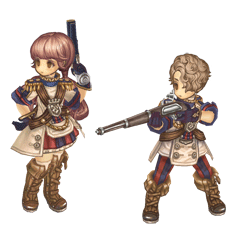
The other class available to Archers at Rank 7. Musketeers are master snipers, experts with handling rifles and sniping enemies one by one.
Tropes associated with Musketeers:
- Anti-Air: Bird Fall does bonus damage to aerial enemies and drops them to the ground
- Bayonet Ya: Can use their muskets to jab nearby enemies
- Boom, Headshot!: The aptly named Headshot skill
- Hakkapalle
One of the classes available to Archers at Rank 8. The Hakkapalle is a cavalry class that wields a one-handed sword alongside a crossbow. Their playstyle is built around alternating between melee and ranged attacks.
Tropes associated with Hakkapalle:
- Beast of Battle: Just as the real cavalry unit it was based of, Hakkapalle can ride companions. However unlike the Schwarzer Reiter, Hakkapalle can dash like a swordsman when riding a companion.
- Bow and Sword in Accord
- Knee-capping: They can shoot their opponents legs to slow them down.
- Use Your Head: cavalry charge makes your companion to charge and ram the enemy.
- Mergen
One of the classes available to Archers at Rank 8. The Mergen is based off the Turkish deity of the same name. They are archers who specialize in the firing many arrows at once, affording them fast AoE attacks.
Tropes associated with Mergen:
- More Dakka: Can easily fire multiple arrows in a single shot.
- Rain of Arrows: Arrow Sprinkle causes the Mergen to jump backward, firing several arrows in rapid succession.
- Bullet Marker
One of the classes available to Archers at Rank 8.
Tropes associated with Bullet Markers:
- Cleric

- "Healing and helping others is the mission of the Clerics. How can you ignore the people seeking help in the name of the Goddess?"
Blessed with the grace of the Goddesses, Clerics employ their divine favor by working miracles, healing the wounded, curing the sick, protecting the vulnerable ... and smashing the wicked into a fine patina of gibs.
Tropes associated with Clerics:
- Damage-Increasing Debuff: Deprotection Zone reduces the defense of enemies standing within it. Casting this right before casting Cure and Heal on the same spot can render groups of foes into greasy puddles very quickly.
- Damage Over Time: This what happens to foes standing within the area enchanted by Cure.
- Dispel Magic: When allies stand on ground enchanted by Cure, the spell will relieve them of status ailments.
- Geo Effects: Those who are used to healers having direct-target skills will be surprised to find out that practically all of a Cleric's skills work by enchanting the ground—even something as basic as Heal!
- Holy Hand Grenade: Heal and Cure are dual-purpose skills. While they help allies, any foes who step on tiles enchanted with them get a face full of holy-element damage. This is not limited to the undead or demonic—instead, it's limited to foes that touch (or hover close enough to) the ground.
- Next Tier Power-Up: Divine Might allows someone who stands on the ground it enchants to use their next skill at a much higher level than normal—just how high depends on the level of the Cleric's Divine Might skill.
- No-Sell: Safety Zone provides anyone standing within its enchanted ground total immunity to damage from attacks—either for 20 seconds, or for a set amount of attacks, whichever comes first. Clerics can learn an attribute to expand the size of the zone so that more than one person can use it.
- Religious Bruiser: In most settings, a person of the cloth abstains from using sharp weapons. The Clerics of Tree of Savior have no such issue—and in fact can take an attribute which encourages using swords with Deprotection Zone.
- Krivis
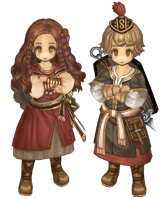
- "Sincerity is our strength. There will be no problems if you sincerely believe and follow the Goddess."
One of the classes that a Cleric can become once they reach Rank 2. The Krivis is based upon the historical krivis, the high priests of the ancient religion of Lithuania. They mainly specialize in strengthening allies and weakening enemies.
Tropes associated with Kriviai:
- Critical Damage-Increasing Debuff: Zalcial increases the critical attack power of allies, while reducing defense to critical hits on foes.
- Heal It With Fire: Using Aukuras, Kriviai summon a sacred torch that increases HP recovery rate for both themselves and their allies.
- Marked to Die: Divine Stigma allows a Krivis to mark an enemy. Anyone who kills that enemy will gain a boost to strength and intelligence.
- Shock and Awe: Zaibas involves a Krivis enchanting a patch of ground, blasting any foe that treads upon it with lightning.
- Status Buff: Notable as an example here because Kriviai can buff the status buffs.
- Daino temporarily raises the cap on the maximum amount of buffs allies can receive.
- Melstis enchants the area around the Krivis, upon which anyone standing within it will have any active buffs maintained for as long as Melstis itself is active.
- Priest
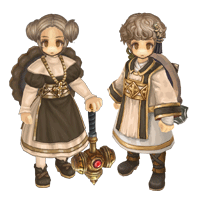
- "Anyone who follows the words of the Goddess can receive her powers to drive out evil spirits. But its strength will depend on the depth of your faith."
The other class available to Clerics at Rank 2. Compared to Kriviai, Priests have the ability to resurrect those slain in battle, but many of their skills require material components.
Tropes associated with Priests:
- Auto-Revive: Revive actually blocks killing blows, while recovering a percentage of HP and rendering its recipient briefly invincible.
- Back from the Dead: Priests wake the fallen with both the Resurrection and Revive.
- Bilingual Bonus: To use the Sacrament skill, Priests require one Gyslotis per use. That's Lithuanian for Plantago.
- Eye of Newt: Nothing so gross, but Aspersion, Blessing, and Sacrament all require material components to cast (holy water, holy powder, and gyslotis respectively).
- Holy Hand Grenade: Like Clerics, Priests have several dual-purpose skills—
- Monstrance will increase an ally's evasion or decrease a foe's physical defense and evasion.
- Aspersion will either buff an ally's defensive strength, or damage a target.
- Resurrection can be used to directly damage enemies rather than revive fallen friends.
- Bokor
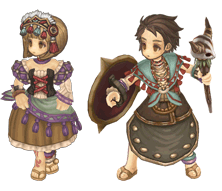
One of the classes available to Clerics starting at Rank 3. Bokors are loosely based on the eponymous practitioners found in several forms of the Vodou religion.
Tropes associated with Bokors:
- Action Bomb: Using the Damballa skill will cause nearby zombies to explode.
- Belated Injury Realization: Using Mackangdal, a Bokor will plant an amulet on a target to stop pain. While Mackangdal is active, the enchanted target will take no damage—but as soon as the effect is over, all the damage they would have taken hits them at once.
- Damage-Increasing Debuff: Hexing a target will lower its magic resistance.
- The Dead Can Dance: As a battle tactic, no less! Bokors can order their zombies to circle around a target area and dance using Bwa Kayiman. This conga line works as area denial, as enemies coming on contact with the zombies get pushed away and take damage.
- Hollywood Voodoo: Although their skillset as a playable class heavily involves zombies and voodoo dolls, this trope is subverted by the fact that Bokors are still Cleric-based classes who retain the skills they learned from their first two Ranks, so they aren't inherently evil or strictly necromancers—and at a specific point in the main storyline, the Bokor Master plays a supporting role that doesn't involve death or zombies.
- The Minion Master: Bokors can command their zombies through Tet Mamak La, which orders them to move to designated locations.
- The Virus: After enchanting a patch of ground with Zombify, enemies either killed by zombies or enemies killed at the location Zombify was cast will turn into more zombies.
- Voodoo Doll: The Effigy skill will damage targets affected by Hexing, and do extra damage on the third casting.
- Witch Doctor: Much more subtle in execution compared to more common examples.
- Dievdirbys

- "Sculptors should be careful not to exaggerate their skills. They should be humble to themselves."
The other class available to Clerics starting from Rank 3. Based on Lithuanian artists who go by the same name and trade, Dievdirbys translates to English as "God Carver." In Tree of Savior, Dievdirbys specialize in carving wooden statues of dieties and sacred icons that affect the battlefield.
Tropes associated with Dievdirbiai:
- Cooldown Manipulation: Dievdirbiai can carve a statue of Laima to reduce cooldown times for nearby allies.
- Monster Organ Trafficking: Carve allows Dievdirbiai to attack enemies with their carving knives. Not only does this do additional damage to Plant-type monsters, but they'll drop carving materials for the Dievdirbys as well.
- No-Sell: Carving a statue of Saulė will give Dievdirbiai and their allies 30 seconds of invincibility—but they must run around the statue three times before it takes effect.
- Power Nullifier: Carving a statue of the Austras Koks (that's Lithuanian for the Tree of the Sun) will cause nearby enemies to be silenced.
- Sentry Gun: A Dievdirbys can carve up an Owl Statue which acts like one of these, shooting green blasts of fiery energy from its eyes.
- Shout-Out: The developers have said that Tree of Savior's Dievdirbiai take inspiration not just from their Lithuanian counterparts, but the Korean light novel series The Legendary Moonlight Sculptor.
- Warp Whistle: A Dievdirbys can carve a statue of Vakarinė to provide a temporary warp station.
- Sadhu
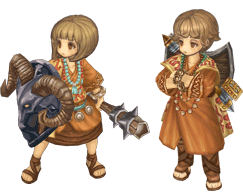
One of the classes available to Clerics at Rank 4, Sadhus are loosely based on the eponymous Hindu ascetics who seek liberation from the cycle of death and rebirth. That's probably why Tree of Savior's Sadhus have so many soul-based skills.
Tropes associated with Sadhus:
- Astral Projection: Punching things with their soul is the signature ability of Sadhus, in fact! While using Out of Body, however, a Sadhu's body is immobile and vulnerable, and the soul can only wander so far.
- Depower: Going beyond a mere debuff, Bashita Siddi allows Sadhus to reduce all the stats of enemies caught in its area of effect for a maximum of ten seconds.
- Flash Step: Using Prakriti will reunite a Sadhu's body and soul at the soul's present location in this manner.
- Having a Blast: Sadhus can use Astral Body Explosion to detonate their soul. You'd think this would make them Deader than Dead, but instead their exploded spirit goes right back into their body with no ill effects whatsoever.
- Liquid Assets: Send Prana allows Sadhus to temporarily transmit a portion of their Intelligence stat to an ally.
- The Paralyzer: Posession combines this with Damage Over Time to render an enemy immobile while damaging them constantly for the duration.
- Paladin

The other class available to Clerics at Rank 4. Being a part of the Cleric class family, they have little in common with their historical counterparts from Charlemange's court, and are more like the usual "holy magic wielding tank" type.
Tropes associated with Paladins:
- Barrier Warrior: Barrier creates an expanding spherical barrier that shoves enemies away as it grows, and prevents them from entering it.
- Damage Reduction: Inverted from the usual form of this trope, the Resist Elements skill reduces damage from Fire, Ice, Lightning, Poison, and Earth Damage Types.
- Gradual Regeneration: Restoration allows Paladins to boost the HP recovery of nearby allies.
- Monster Allies: Paladins can enchant ground with Conversion, which will turn monsters to their side.
- The Paladin
- Smite Evil: Smite is a hard-hitting melee attack Paladins can learn, although it's purely a physical one and doesn't necessarily hurt evil alone.
- Turn Undead: They've got the "chance of instant kill" variant, and it'll work on both Mutant and Demon enemies.
- Warrior Monk: A Western variant.
- Monk

One of the classes available to Clerics at Rank 5. They are loosely based on the famous Shaolin monks—at least in the sense that they are ascetics who practice martial arts. We're pretty sure Shaolin monks can't shoot energy beams—we think.
Tropes associated with Monks:
- Attack Reflector: Iron Skin will reflect a percentage of damage back to attackers, but it won't do so against magic attacks.
- Armor-Piercing Attack: Hand Knife is said to destroy enemy shields and armor. Using this technique will send enemies high into the air.
- Bare-Fisted Monk: Most of a Monk's skills are bare-fisted, but as of yet there are no weapons that would allow a Monk to punch things as part of a normal attack.
- Cast from Money: Golden Finger Flick involves a Monk flicking Silver coins at foes, and will use up a certain amount of money with each use. Goemon would be proud.
- Kamehame Hadoken: Energy Blast looks like and works very similarly to Son Goku's signature Kamehameha.
- Punched Across the Room: Two flavors are available to Monks—
- Palm Strike might involve an open palm rather than a fist, but it'll send enemies flying all the same.
- One Inch Punch will also send an enemy flying, but its primary purpose is to reduce enemy SP.
- No-Sell: Golden Bell Shield renders a Monk temporarily invulnerable to any attack.
- Rapid-Fire Fisticuffs: Double Punch may only hit twice, but it has no Cooldown (nor does it consume SP). Instead, it uses two points of Stamina, making it very spammable.
- Warrior Monk: An Eastern variant.
- Pardoner
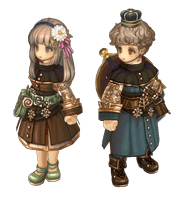
Another one of the classes available for Clerics upon reaching Rank 5, and the crafting class of the Cleric family. Pardoners are loosely based on the eponymous Medieval lay clergymen of the Catholic Church, who acted as fundraisers by selling indulgences.
Tropes associated with Pardoners:
- Cast from Money: Indulgentia works like a stronger version of a Cleric's Cure, but it costs a chunk of Silver per use.
- Item Crafting: Using Simony, Pardoners can create scrolls which allow non-Clerics to use a Cleric skill.
- Status Effects: Notable here for the same reasons Status Buff is notable for Krivai—Discerning Evil allows a Pardoner to prolong the status ailments affecting a target.
- Player-Generated Economy: Spell Shop allows Pardoners to set up an automated vending system in which they can sell their spellcasting services for a price.
- Chaplain
A hidden class, available to Clerics at Rank 5. The Chaplain expands on the Priest's abilities with an offensive edge, allowing them to condense the effects of their various buffs into a single skill as well as splash holy water with every attack.
Tropes associated with Chaplains
- Prestige Class: So far the only class that requires a certain rank in another class in order to be obtained, in this case being Circle 3 Priest
- Turns Red: Last Rites increases the damage of Party Members, even more so when their health drops below 40%.
- Druid
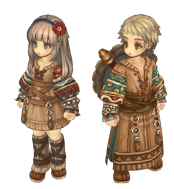
One of the classes that Clerics can pick from once they reach Rank 6. As with the Paladins, they're more based on the modern interpretation of them being nature-themed magic users than they are on the historical Celtic druids.
Tropes associated with Druids:
- Druid: Their skillset has a lot of the powers expected of Druids.
- Elemental Barrier: Sutorea-Tropez will cause grass within the target area to protect Druids and their allies.
- Green Thumb: Exactly half of their skillset involves manipulation of plants. For example, Cortasmata will grow grass in a target area—any enemies entering that area will be counted as Plant creatures (and thus susceptible to skills affecting those).
- Man-Eating Plant: Carnivory will command grass and flora within a target area to attack a Druid's enemies.
- People Puppets: Telepathy allows a Druid to take direct control of their target's body for a period of time.
- Voluntary Shapeshifting: Shape Shifting lets Druids transform into whatever insect, plant, or animal-type monster is in front of them. Using Transform, they can also assume the shape of the previous creature into which they had shifted.
- Our Werewolves Are Different: Lycanthropy, a skill in Circle 3, allows them to transform into werewolves.
- Oracle
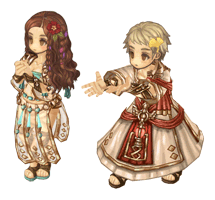
The other class available to Clerics upon reaching Rank 6, Oracles take after the eponymous priests and priestesses of Classical Greece. As such, their skillset has much to do with precognition and making predictions, albeit of a more tactical, immediate nature.
Tropes associated with Oracles:
- Combat Clairvoyance: Forecast allows an Oracle to see danger zones preceding every enemy's attack—even the regular, physical attacks from common monsters. This allows the Oracle (and others) to get out of the way and avoid getting hit entirely.
- Dispel Magic: Counterspell works like this—it removes enchanted ground and magic circles cast by the enemy.
- Enemy Scan: An interesting variaton—Clairvoyance allows Oracles to find out what items a monster will drop when they are killed. They can even change what the monster will drop by using the Resetting skill, making Oracles ideal party members for farming for rare items.
- Forced Transformation: Using Change, an Oracle can randomly morph a monster into something else.
- No-Sell: A specific type of no-selling, Oracles can use Prophecy to temporarily render their party immmune to status ailments.
- Status Buff: Using Arcane Energy, Oracles can temporarily increase the maximum amont of SP and stamina that they and their allies can have.
- Summon Magic: Call of Deities will randomly summon monsters in front of the Oracle—though not as allies, as prey. The kind of monsters summoned depend on what monsters are found in the field where the Oracle is located.
- You Are Already Dead: Oracles get to do this with the Death Sentence skill.
- Plague Doctor

One of the classes available to Clerics at Rank 7. Drawing inspiration from the doctors of The Black Death, Plague Doctors specialize in preventing Status Effects from affecting themselves or their allies.
Tropes associated with Plague Doctors:
- Healing Factor: The aptly named Healing Factor skill temporarily applies a buff in which anyone who receives it will rapidly regenerate health when receiving damage
- Kill It with Fire: Through Incineration, Plague Doctors can unleash a flamethrower that will deal more hits the more status ailments an enemy has on them.
- No-Sell: Beak Mask prevents status ailments from affecting the Plague Doctor, while Bloodletting applies a weak bleed on allies that in turn, negates most other status ailments
- Plague Doctor: Well of course
- Kabbalist

The other class available to Clerics at Rank 7. Based off the Judaist practice of Kabbalah, Kabbalists are a mathematician's class, able to use numbers to alter an enemy's level, or reflect damage by seven times amount.
Tropes associated with Kabbalists:
- Attack Reflector: Revenged Sevenfold applies a buff that reflects seven times the amount of damage they receive within its duration
- Formulaic Magic: Their magic is basically formed around equations
- Level Drain: Reduce Level drops an enemy's level based on the number calculated by their other skills, Gematria and Notarikon
- Mechanically Unusual Class: They can calculate numbers based off the letters of an enemy's name and the number of letters in their name.
- Inquisitor
Tropes associated with Inquisitors:
- Anti-Magic: Pear of Anguish will do a fair amount of damage if triggered by being stepped on. If triggered by the presence of an enemy using magic, it'll home in on them and deal three times as much damage
- Mage Killer: Their playstyle is geared strongly against magic users.
- Taoist
Tropes associated with Taoists:
- Paper Talisman: All of their skills are themed around deploying and setting off Talismans.
- Zealot
Tropes associated with Zealots:
- Swordsman
- Highlander
- Peltasta
- Murmillo
- Wizard
- Elementalist
- Pyromancer
- Cryomancer
- Archer
- Ranger
- Fletcher
- Mergen
- Cleric
- Paladin
- Inquisitor
- Plague Doctor
- Scout
- Rogue
- Assassin
- Shinobi
- Valentinas Naimon"The goddess left many things to the first Paladin. The threat of the demon lord Gesti and the mission to protect this place."
One of the Four Heroes who worked to save as many people as they could during the Medis Diena. Valentinas personally rescued many survivors in the capital city, and for that he is the most celebrated of the four among the people of the Kingdom.
Valentinas is also the Paladin Master, and the go-to man for Clerics wishing to become Paladins. At the start of the story, he resides in the Srautas Canyon/Gele Plateau/Nefritas Cliff region, upholding the promises that the first Paladin, Rimgaudis, made to Goddess Laima hundreds of years ago.
Tropes associated with Valentinas Naimon:
- The Bait: Valentinas attempts to use a divine crystal (called alternately a "divine heal" by Valentinas and the Followers) to keep Demon Lord Gesti from finding the revelation—both by misleading her into thinking it is the revelation she's after, and as a weapon to stop her. Unfortunately, it doesn't work.
- Feeling Their Age: He sends you on ahead to Tenet Chapel after the battle with Throneweaver. It seems powering the divine crystal took too much out of him, but he blames it on his old body not wanting to follow his will any longer.
- MacGuffin Guardian: He and the Followers comprise an inversion of the trope—they're there to protect the revelation until the Revelator comes to collect it. You wind up having to help him—and them—fend off the demons who come looking for the revelation.
- Demon Lord Gesti"So, the Revelator has come here to die."
One of the three Demon Lords serving Giltine, and the first one encountered by the Revelators. She's after the revelation entrusted to the first Paladin by Laima.
Tropes associated with Demon Lord Gesti:
- Hellish Pupils: A piercing shade of green, at that.
- Impossibly-Low Neckline: To prevent a Wardrobe Malfunction, she keeps her top in place with a chain.
- Leitmotif: "O Deive" by S.F.A
 plays just about every time she confronts you (battle or no).
plays just about every time she confronts you (battle or no). - The Pawns Go First: Several times prior to the showdown in Tenet Chapel, she'll leave one of her subordinate boss monsters to fight you rather than deal with you personally.
- Pimped-Out Dress: As befitting her lordship.
- Demon Lord Hauberk"From the beginning, all of you were the same. I have been fooled."

Used to be the most powerful demon lord, who was notorious for his brutality and also commanded the largest army. He signed a secret treaty with one of the greatest wizards in the world, Agailla Flurry, but after that treaty had been discovered by Demon Lord Helgasercle, his body was ripped apart, scattered and sealed into pieces across the world.
Tropes associated with Demon Lord Hauberk:
-
 Ensemble Dark Horse: There have been quite an amount
Ensemble Dark Horse: There have been quite an amount of
of fanart
fanart submitted about him and many players have stated how he is one of the most empathetic and memorable characters and that they actually stopped skipping through dialogue just to read his lines.
submitted about him and many players have stated how he is one of the most empathetic and memorable characters and that they actually stopped skipping through dialogue just to read his lines. - Heel–Face Turn: Only temporarily sides with the Goddesses to get revenge on the other demon lords and also for the chance to become whole again.
- Identity Amnesia: His other pieces do not seem to remember his dark past and the horrible deeds that he had committed.
- Literal Split Personality: His soul is divided into pieces containing his wisdom, compassion, pride and brutality.
- Noble Demon: One of the pieces of his soul that the player meets actually cares about his current human host Agatas, enough to ask the player to collect herbs to heal his host and he later decides to stay with Agatas to fulfill his promise.
- Our Demons Are Different: While he's fighting by the player's side, holy healing magic actually heals him instead of damaging him.
- Unwitting Pawn: To the goddesses who hid the fact that they wanted to use his soul as a "cork" to seal a hole in the demon prison.
- Walking Shirtless Scene: He's a giant fluffy demon.
- Laima, Goddess of Destiny"Much time will have drifted between us when you see this message. I am the Goddess of Fate and Wisdom—Laima."
One of the five main goddesses who controls the domains of destiny and prophecy. She's one of the more obscure ones among the common people—in fact, some say she's never shown herself before. Some even doubt whether or not she's actually a deity.
Tropes associated with Laima:
- Fling a Light into the Future: In the year 495, Laima foresaw the coming cataclysm, the disappearance of the other Goddesses, and who was responsible. She sought a way to combat the demonic invasion, and found one in ... You. The tablets and messages (revelations) she's left behind for the Relevators comprise the "light" she's flung into the future.
- Living MacGuffin
- Sealed Good in a Can: To hide from the demons, she divided and sealed herself into the messages she's left behind. Upon finding the first tablet, she tasks the Revelator with finding the rest so she can become whole again, and thus lend her aid directly.
- Spirit Advisor: Considering that the revelations she's left for the Revelator are in fact pieces of her being, and these revelations contain information on what she's forseen and what to do next, Laima counts as one.
- Gabija, Goddess of Fire
Another one of the five main goddesses. As quoted in the Pyromancer entry, it's said that anyone who employs fire magic has been graced by Gabija, but even common people in the kingdom pray to her to keep their homes warm.
Tropes associated with Gabija:
- Zemyna, Goddess of Earth
Of the five main goddesses, Zemyna has dominion over the earth. Zemyna also governs agriculture, so farmers seek to be in her good graces to ensure a bountiful harvest.
Tropes associated with Zemyna:
- Saulė, Goddess of the Sun
As the embodiment of the sun and one of the five main goddesses, Saulė brings the morning after every night. She also governs life, fertility, warmth and health—and when mortals die, their souls go to her.
Tropes associated with Saulė:
- Spell My Name With An S: In the English Tree of Savior closed beta, her name was spelled "Ausrine."
- Vakarinė, Goddess of the Evening Star
Another one of the five main goddesses, Vakarinė guides the evening star and wakes Saulė at every morning. She is also considered the guardian of travelers, with energy and rest being both within her sphere of influence. The common folk hold that saying her name three times will bring relief to an exhausted wayfarer.
Tropes associated with Vakarinė:
- Red Sky, Take Warning: An inversion—it's said that stars that glitter red in the sky are the very symbol of Vakarinė. Considering she's a deity ...
- Spell My Name With An S: Her name was spelled "Vakarine" in the Tree of Savior closed English beta.
- Warp Whistle: Her statues are the primary means of transportation.
- Giltine, Goddess of Death
Tropes associated with Giltine:
- Big Bad: In her second revelation, Goddess Laima says it's Giltine who's commanding the three demon kings and their host of demons.
- Kill All Humans: Goddess Laima says this is her end goal.
